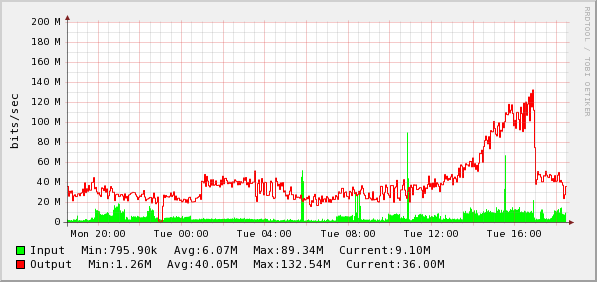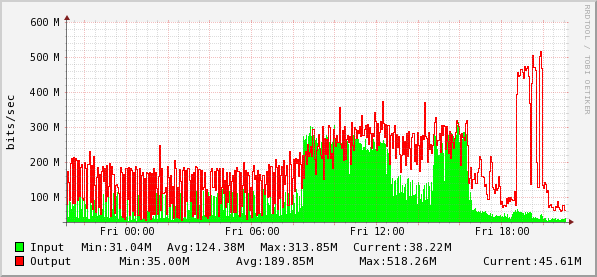Introduction
The PR-NETS project is a NSF-funded activity to construct a ScienceDMZ in the UPR-RP campus to expedite the transmission of science data across and off-campus.
UPR-RP has a sequencing facility. Prior to the CC-NIE award, Riccardo Papa contacted me to transfer 500 GB sequencing data from an external drive to the HPCf.
He had tried several times without success to transfer the files from his laboratory. I set up a scp transfer from a workstation in my lab, but after some time the session timed out and the transfer failed. It took 3 days and repeated restarts to complete the file transfer, obtaining a maximum throughput of 127 Mbps, in March 2012.

Figure 1: Total traffic to the HPCf in March 2012, showing a partial transfer of 500 GB sequencing data.
In the CC-NIE proposal, we documented how we were able to transfer files using Globus Connect, a specialized tool for bulk data transfer. In February 2013, prior to the establishment of the ScienceDMZ, the transfers using Globus Connect ran at a maximum rate of 132 Mbps.

Figure 2: Total traffic to the HPCf February 4-5, 2013. This traffic includes tests of Globus Connect with a 50 GB test data set.
Methods
We were awarded the PR-NETS grant to create a ScienceDMZ at UPR-RP. We created a 10 Gbps Ethernet backbone within the campus using Cisco switches. We purchased Intel 10 GE network cards (Intel Ethernet Server Adapter X520-DA2) for several workstations in the Computer Science department, including mine. My workstation is attached to a Cisco Catalyst 4500-X over TwinAx cabling. The Catalyst has a fiber optic connection to the ScienceDMZ switch router, a Cisco Catalyst 6506 in central IT. The ScienceDMZ is connected directly to the campus router, and from there over a 1 GE link to the HPCf via AT&T, rate limited to 300 Mbps.
On August 1, 2014, I transferred 400 GB sequencing data and partial sequence assembly results from UPR-RP to HPCf, and 159 GB raw sequence data from the HPCf to UPR-RP. The transfers were performed using Globus Connect.
Results
The attached network utilization graphs show the sustained throughput achieved with Globus Connect on the ScienceDMZ. Upload from campus to the HPCf runs around 300 Mbps, transfers from HPCf to UPR-RP ran over 500 Mbps.

Figure 3: Total campus traffic on August 1, 2014, showing bulk transfers with Globus Connect in both directions.

Figure 4: Total traffic at the HPCf on August 1, 2014.
The download was interrupted by the expiration of the client credentials for Globus Connect. The transfer resumed as soon as the credentials were refreshed. The upload shows short interruptions as well, and fluctuation in the data rate. Data transfer rates are also measured by the Globus Connect application, Globus Connect reported an average bandwith for transfers from HPCf to UPR-RP of 298 Mbps. The reported average bandwidth for Globus Connect from UPR-RP to HPCf on August 2 was 212 Mbps when total bandwidth to the campus was 300 Mbps.
Discussion
The ScienceDMZ allows much higher throughput data transfers, with fewer interruptions than the campus network. We are able to saturate the WAN link to campus, where before we only obtained about a third of the available bandwidth.
The ScienceDMZ and associated tools will allow researchers to move large files on and off campus, permitting their participation in data-intensive science projects. We look forward to collaborating with other researchers with similar data transfer requirements.
Acknowledgments
The PR-NETS project is supported by NSF award 1340959 to Dr. Jose Ortiz-Ubarri, Dr. Rafael Arce-Nazario and Dr. Humberto Ortiz-Zuazaga. We would like to thank Dr. Riccardo Papa for loaning us his data and motivating the case study.